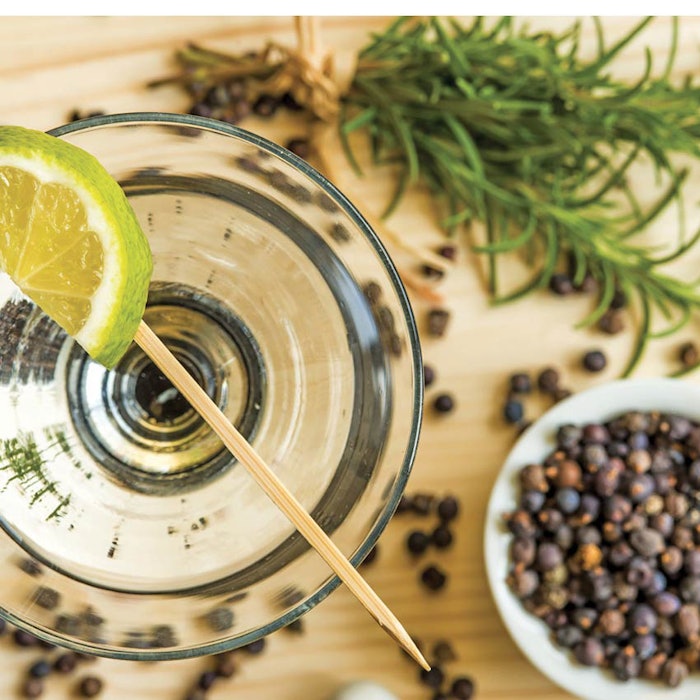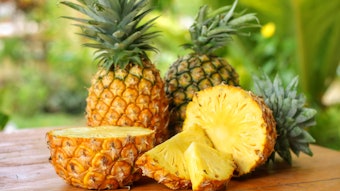
There are seven varieties recognized for Juniperus communis L. They are: J. communis var. communis, J. communis var. megistocarpa Fernald et H. St. John, J. communis var. depressa Pursh, J. communis var. charlottensis R. P. Adams, J. communis var. Jackii Rehdes, J. communis var. saxatilis Pall. and J. communis var. nipponica (Maxim.) E. H. Wilson (Adams 2011).
The complexity associated with the composition of juniper berry oil is a combination of varietal selection although most studies were performed on berries from J. communis var. communis and the maturity of the berries used to produce the oil. In addition, the oil composition is also affected by the other intrinsic conditions, as well as the extrinsic conditions.
Currently, juniper berry oils can be found originating from Albania, Austria, Bosnia-Herzegovina, Bulgaria, Croatia, France, Hungary, Italy and Turkey, while studies on the potential for commercial production of oil have been conducted in Finland, Greece, Lithuania, Montenegro, Norway, Poland, Portugal, Romania, Russia, Serbia and Spain.
Juniper berries and their oils are used in seasoning mixtures in the food industry as flavorings in marinades for meat and fish, as well as in beverages such as tea, beer and brandy (de Groot and Schimdt, 2016). However, it is well known that gin and genever could not exist without juniper berries.
More than 250 compounds that have been reported as being constituents of juniper berry oil in the previously published reviews (Lawrence, 1977, 1980, 1984, 1985, 1987, 1990, 1996, 2001, 2006, 2008 and 2012) are listed below. These unequivocally characterized constituents, which are listed in elution order from a non-polar capillary column are as follows:
tricyclene (t–2.0%)
α-thujene (0.1–3.6%)
α-pinene (10.8–70.8%)
camphene (t–1.9%)
sabinene (0.1–19.4%)
β-pinene (0.1–13.7%)
myrcene (0.1–24.4%)
α-phellandrene (t–3.3%)
δ-3-carene (t–4.3%)
α-terpinene (t–4.1%)
p-cymene (t–11.9%)
limonene (0.1–31.0%)
β-phellandrene (t–3.3%)
1,8-cineole (t–0.6%)
(E)-β-ocimene (t–0.3%)
γ-terpinene (t–6.9%)
cis-sabinene hydrate (t–0.3%)
terpinolene (t–4.7%)
p-cymenene (t–0.6%)
linalool (t–1.9%)
α-pinene oxide (t–0.4%)
α-fenchyl alcohol (t–0.7%)
cis-p-menth-2-en-1-ol (t–0.6%)
α-campholenic aldehyde (t–4.1%)
trans-pinocarveol (t–4.3%)
trans-p-menth-2-en-1-ol (t–0.2%)
trans-sabinene hydrate (t–0.35%)
cis-verbenol (t–3.3%)
camphor (t–1.5%)
trans-verbenol (t–2.2%)
p-mentha-1(7),2-dien-8-ol (t–1.6%)
borneol (t–8.0%)
p-mentha-1,5-dien-8-ol (t–4.5%)
terpinen-4-ol (0.1–9.6%)
α-terpineol (0.1–6.0%)
myrtenol (t–1.5%)
trans-dihydrocarvone (t–0.4%)
verbenone (t–3.9%)
trans-carveol (t–1.7%)
nerol (t–2.2%)
cis-carveol (t–0.5%)
citronellol (t–1.3%)
carvone (t–0.4%)
geraniol (t–1.6%)
trans-myrtanol (t–0.3%)
methyl citronellate (t–3.6%)
bornyl acetate (t–6.7%)
thymol (t–2.5%)
2-undecanone (t–0.2%)
trans-pinocarvyl acetate (t–0.3%)
carvacrol (t–0.8%)
myrtenyl acetate (t–0.1%)
α-terpinyl acetate (t–2.8%)
α-cubebene (t–2.0%)
neryl acetate (t–1.5%)
α-copaene (t–1.0%)
geranyl acetate (t–0.3%)
β-bourbonene (t–0.4%)
β-elemene (t–2.6%)
longifolene (t–1.2%)
β-caryophyllene (0.1–11.3%)
cis-thujopsene (t–0.4%)
γ-elemene (t–3.3%)
β-gurjunene (t–0.5%)
aromadendrene (t–0.6%)
cis-muurola-3,5-diene (t–0.3%)
trans-muurola-3,5-diene (t–0.2%)
α-humulene (t–7.6%)
(E)-β-farnesene (t–5.0%)
cis-muurola-4(14),5-diene (t–0.2%)
γ-muurolene (t–1.3%)
trans-cadina-1(6),4-diene (t–0.1%)
germacrene D (0.1–12.1%)
citronellyl isobutyrate (t–0.7%)
β-selinene (t–1.2%)
δ-selinene (t–0.8%)
bicyclogermacrene (t–0.6%)
trans-muurola-4(14),5-diene (t–0.4%)
α-muurolene (t–1.7%)
β-bisabolene (t–2.0%)
γ-cadinene (0.1–12.1%)
endo-1-bourbanol (t–0.2%)
δ-cadinene (0.1–8.7%)
α-calacorene (t–0.2%)
cadina-1(2),4-diene (t–0.2%)
α-cadinene (t–2.5%)
germacrene B (t–0.4%)
elemol (t–1.8%)
germacrene D-4-ol (t–3.1%)
spathulenol (t–1.7%)
caryophyllene oxide (t–10.0%)
salvial-4(14)-en-1-one (t–0.5%)
humulene epoxide II (t–2.1%)
cedrol (t–1.8%)
1,10-di-epi-cubenol (t–0.3%)
1-epi-cubenol (t–0.8%)
γ-eudesmol (t–0.5%)
T-cadinol (t–3.5%)
T-muurolol (t–2.5%)
α-muurolol (t–1.2%)
α-cadinol (t–8.6%)
selin-11-en-4α-ol (t–0.4%)
14-hydroxy-9-epi-β-caryophyllene (t–1.8%)
selina-4(15),7-dien-1β-ol (t–1.1%)
selin-7(11)-en-4-ol (t–0.8%)
14-hydroxy-α-humulene (t–0.8%)
t = trace (<0.1%)
Romeo et al. (2008) analyzed an oil of juniper berry that was obtained commercially in Italy. It was found to possess the following composition:
α-pinene (29.2%)
camphene (0.6%)
benzaldehyde (0.5%)
sabinene (0.1%)
β-pinene (8.7%)
myrcene (0.8%)
δ-3-carene (0.7%)
p-cymene (1.0%)
limonene (13.2%)
1,8-cineole (2.9%)
linalool (0.2%)
α-fenchyl alcohol (0.7%)
allo-ocimene* (2.6%)
trans-pinocarveol (1.9%)
(E,E)-allo-ocimene (0.7%)
borneol (0.8%)
terpinen-4-ol (2.7%)
p-cymen-8-ol (2.2%)
α-terpineol (6.0%)
myrtenol (1.6%)
verbenone (2.5%)
trans-carveol (0.8%)
cis-carveol (0.5%)
carvone (0.3%)
bornyl acetate (0.5%)
longifolene (1.2%)
isocaryophyllene (0.5%)
α-humulene (0.4%)
α-muurolene (0.3%)
γ-cadinene (0.3%)
germacrene D-4-ol (0.6%)
*correct isomer not identified
Williams (2008) reported that a Bulgarian oil of juniper berries possessed the following composition:
α-thujene (1.3%)
α-pinene (31.8%)
camphene (0.3%)
sabinene (2.3%)
β-pinene (2.8%)
myrcene (14.7%)
α-phellandrene (0.7%)
δ-3-carene (1.0%)
α-terpinene (1.1%)
p-cymene (1.9%)
limonene (4.5%)
β-phellandrene (2.7%)
γ-terpinene (2.3%)
terpinolene (1.4%)
terpinen-4-ol (8.8%)
α-terpineol (2.0%)
α-cubebene (0.6%)
β-elemene (0.7%)
β-caryophyllene (0.8%)
cis-thujopsene (2.3%)
α-humulene (0.8%)
germacrene D (1.8%)
δ-cadinene (1.7%)
germacrene B (0.5%)
caryophyllene oxide (1.7%)
In addition, trace amounts (<0.1%) of α-fenchene, p-cymenene, linalool, trans-pinocarveol, borneol, verbenone, citronellol, bornyl acetate, isoamyl isovalerate, α-copaene, γ-muurolene, β-selinene, α-muurolene, α-selinene, cuparene, T-cadinol and α-cadinol were also reported as constituents of this oil.
A commercial oil of juniper berry was screened by Wanner et al. (2010) for its antibacterial activity. Analysis of the oil using GC-FID and GC/MS revealed that it possessed the following composition:
tricyclene (0.1%)
α-thujene (0.7%)
α-pinene (35.4%)
α-fenchene (0.1%)
camphene (0.5%)
thuja-2,4(10)-diene (0.1%)
sabinene (7.6%)
β--pinene (3.3%)
p-mentha-2,8-diene (0.3%)
myrcene (15.3%)
p-mentha-1(7), 8-diene (0.7%)
δ-3-carene (0.1%)
α-terpinene (0.5%)
p-cymene (2.1%)
limonene (7.3%)
(E)-β-ocimene (0.1%)
γ-terpinene (1.8%)
terpinolene (1.2%)
linalool (0.2%)
trans-pinocarveol (0.1%)
terpinen-4-ol (2.4%)
α-terpineol (0.2%)
α-fenchyl acetate (0.1%)
bornyl acetate (0.2%)
α-terpinyl acetate (0.1%)
α-cubebene (0.5%)
α-copaene (0.5%)
β-elemene (0.6%)
β-caryophyllene (4.2%)
cis-thujopsene (0.3%)
(E)-β-farnesene (0.3%)
α-humulene (1.2%)
germacrene D (1.8%)
γ-cadinene (0.4%)
δ-cadinene (1.5%)
Lohani et al. (2010) examined a hydrodistilled oil of the air-dried berries of J. communis collected from Shibok (Chamoli district, Uttarakhand, India) using GC/MS and retention indices. The constituents characterized in this study were:
α-thujene (0.3%)
α-pinene (10.8%)
camphene (0.2%)
verbenene (0.2%)
sabinene (5.4%)
β-pinene (1.3%)
myrcene (3.6%)
δ-2-carene (0.1%)
δ-3-carene (0.5%)
α-terpinene (0.2%)
p-cymene (0.1%)
limonene (15.1%)
1,8-cineole (0.2%)
γ-terpinene (0.4%)
cis-sabinene hydrate (0.2%)
terpinolene (0.2%)
trans-sabinene hydrate (0.3%)
linalool (0.5%)
α-thujone (0.3%)
β-thujone (0.3%)
p-menth-2-en-1-ol* (0.2%)
α-campholenic aldehyde (1.8%)
trans-pinocarveol (0.2%)
cis-verbenol (3.3%)
trans-verbenol (2.2%)
citronellal (0.7%)
borneol (0.5%)
terpinen-4-ol (8.8%)
p-cymen-8-ol (1.2%)
α-terpineol (1.1%)
myrtenol (1.5%)
verbenone (0.6%)
trans-carveol (1.7%)
citronellal (1.3%)
cis-carveol (0.4%)
myrtenyl acetate (5.0%)
carvone (0.8%)
methyl citronellate (3.6%)
bornyl acetate (1.4%)
thymol (0.1%)
α-terpinyl acetate (0.2%)
α-cubebene (0.2%)
α-copaene (0.1%)
β-cubebene (0.5%)
β-elemene (0.5%)
β-bisabolene (2.0%)
γ-cadinene (0.3%)
elemol (1.0%)
germacrene B (0.5%)
caryophyllene oxide (0.3%)
T-muurolol (1.8%)
cubenol (0.1%)
α-muurolol (0.3%)
α-eudesmol (0.1%)
α-cadinol (0.9%)
α-bisabolol (1.6%)
*correct isomer not identified
Trace amounts (<0.05%) of tricyclene and β-eudesmol were also found in this oil.
Two commercial samples of juniper berry oil were reported by Vossen (2011) to possess the following composition:
α-thujene (0.6–0.9%)
α-pinene (32.2–37.6%)
camphene (0.3%)
verbenenet (0–0.1%)
sabinene (4.9–8.9%)
β-pinene (2.0–2.5%)
myrcene (21.2–25.7%)
α-phellandrene (0–0.1%)
δ-2-carene (0–0.4%)
α-terpinene (0–0.3%)
p-cymene (0.3–0.6%)
limonene (4.3–4.4%)
γ-terpinene (0.5–0.7%)
terpinolene (0.8–1.1%)
linalool (0.2–0.3%)
terpinen-4-ol (1.0%)
α-terpineol (0.2%)
bornyl acetate (0.2–0.3%)
α-cubebene (0.6–0.7%)
α-copaene (0.7–0.8%)
β-elemene (0.8–1.1%)
epi-zonarene (0–0.2%)
γ-muurolene (0–0.3%)
β-caryophyllene (2.2–2.6%)
γ-elemene (0.2–0.3%)
α-humulene (2.3–2.8%)
γ-cadinene (0.7–0.8%)
germacrene D (6.0–7.5%)
β-selinene (0.2–0.3%)
β-gurjunene (0–0.4%)
α-selinene (0–0.4%)
bicyclogermacrene (0.2–0.5%)
α-muurolene (0.7%)
γ-gurjunene (0–0.2%)
germacrene A (0–0.3%)
γ-cadinene (0.7%)
δ-cadinene (2.6–2.8%)
α-cadinene (0–0.2%)
germacrene B (1.1–1.9%)
δ-cadinene† (0.1–0.3%)
γ-cadinene† (0–0.2%)
β-guaiene† (0–0.1%)
†incorrect identification
t = tentative identification
An oil of juniper berries of Albanian origin was analyzed by Hodaj et al. (2015) using GC/MS and retention indices only. The constituents characterized in this oil were:
α-thujene (0.1%)
α-pinene (35.8%)
camphene (0.3%)
sabinene (10.0%)
myrcene (19.9%)
α-phellandrene (0.1%)
δ-3-carene (0.5%)
p-cymene (0.7%)
limonene (3.5%)
γ-terpinene (1.0%)
terpinolene (1.0%)
linalool (0.1%)
terpinen-4-ol (2.2%)
p-cymen-8-ol (0.1%)
α-terpineol (0.3%)
bornyl acetate (0.3%)
α-cubebene (0.7%)
α-copaene (0.9%)
β-elemene (1.5%)
sibirene (0.2%)
β-caryophyllene (2.0%)
β-copaene (0.1%)
γ-elemene (0.5%)
α-humulene (1.7%)
(E)-β-farnesene (0.8%)
trans-cadina-1(6),4-diene (0.1%)
γ-muurolene (1.0%)
germacrene D (4.5%)
β-selinene (0.4%)
trans-muurola-4(14), 5-diene (0.1%)
viridiflorene (0.9%)
α-muurolene (0.7%)
δ-amorphene (0.1%)
γ-cadinene (1.0%)
δ-cadinene (2.9%)
α-cadinene (0.2%)
selina-3,7(11)-diene (0.2%)
germacrene B (1.3%)
spathulenol (0.1%)
α-muurolol (0.1%)
α-cadinol (0.1%)
Trace amounts (<0.05%) of tricyclene, thuja-2,4(10)-diene, α-campholenal, trans-pinocarveol, borneol, citronellol, an undecanone isomer, citronellyl acetate, α-ylangene, aromadendrene, cis-muurola-3,5-diene, cis-muurola-4(14)-5-diene, β-calacorene, caryophyllene oxide, humulene epoxide II,1-epi-cubenol and cubenol were also found in this oil.
The constituents characterized using a combination of GC-FID and GC/MS in the commercial oils of juniper berry obtained from Austria, Bosnia-Herzegovina, Slovenia, Germany, Croatia, France, Italy, Hungary and Turkey were reported by de Groot and Schmidt (2016) to be as follows:
xylene* (0–1.8%)
tricyclene (0.1–2.0%)
α-thujene (0.1–1.3%)
α-pinene (18.1–66.6%), (25–45%)a
camphene (0.3–1.0%)
sabinene (1.0–17.7%), (4–20%)a
β-pinene (1.8–7.8%), (1–12%)a
myrcene (11.6–21.6%), (3–22%)a
pseudolimonene (0.3–0.7%)
α-phellandrene (<0.1–2.0%)
δ-3-carene (0.1–0.9%)
α-terpinene (0.1–2.0%)
p-cymene (0.4–2.3%)
limonene (2.5–7.6%), (2–9%)a
β-phellandrene (0.4–0.9%)
(E)-β-ocimene (<0.1–0.1%)
γ-terpinene (0.4–4.5%)
terpinolene (0.5–2.1%)
p-cymenene (<0.1–0.2%)
linalool (0–0.2%)
α-pinene oxide (<0.1–0.1%)
α-fenchyl alcohol (<0.1–0.1%)
borneol (<0.1–0.1%)
terpinen-4-ol (1.9–5.4%), (1–6%)a
α-terpineol (0.2–1.1%)
myrtenol (<0.1–0.1%)
citronellol (0–0.1%)
carvone (0–0.1%)
bornyl acetate (0.1–0.3%), (0–0.6%)a
α-cubebene (0.1–1.0%)
α-copaene (0.1–0.4%)
β-elemene (0.2–0.9%)
longifolene (1.2–1.4%)
β-caryophyllene (2.5–5.9%), (1.5–5.0%)a
cis-thujopsene (<0.1–0.4%)
γ-elemene (0.3–0.7%)
α-humulene (0.5–2.2%), (1–4%)a
(E)-β-farnesene (0.2–0.6%)
germacrene D (0.1–2.6%), (1–5%)a
α-muurolene (0.2–1.7%)
γ-cadinene (0.1–0.7%)
δ-cadinene (0.3–2.7%), (1.0–3.5%)a
spathulenol (0.1–0.3%)
caryophyllene oxide (<0.1–0.4%)
T-cadinol (0.5–2.5%)
4-epi-abietal (<0.1%)
*correct isomer not identified
aISO 8897 (2010)











